Designing the Warhammer 40,000 Commander Decks
Welcome to the grimdark of the far future! Today I'll talk about the nitty-gritty design decisions we made while adapting the universe of Warhammer 40,000 into Magic cards. For a higher-level view of the design challenges of Universes Beyond sets more generally, be sure to check out Mark Rosewater's article! You can also preorder Warhammer 40,000 Commander decks from your local game store and at online retailers like Amazon.
I'll begin by introducing the (extremely handsome) design team. The Warhammer 40,000 set didn't have a traditional handoff from Vision Design to Set Design; it was more of a gradual shift as folks rotated off the team and were replaced one by one.
Click here to meet the team
Matt Danner
Matt, or rather Danner as he's known here, was on the design team during its early stages. His boundless enthusiasm for Warhammer 40,000, coupled with his understanding of how to create a marketable product, helped to propel us into the most compelling direction. Interestingly, Danner was involved in the product at the beginning—during the earliest stages of game design—and near the end, helping guide the copy and package design in his capacity as senior creative lead on the Worldbuilding team.
Daniel Holt
Daniel used to play Magic competitively before he was hired at Wizards. Denied a competitive outlet, he has adopted Commander as his format of choice. As the senior UX designer for tabletop Magic, Daniel's primary responsibility is to design new card frames and symbols, but he also stays active on Commander and Set Design teams as well. For the Warhammer 40,000 set, Daniel worked on the late stages of design, refining the gameplay of the cards and the preconstructed decks.
Noah Millrod
Noah was involved in a variety of departments at Wizards. I had the pleasure of working with him on several design teams over the years. He is one of those omni-competent people who seems to excel at any sort of job, or maybe he was just really good at effortlessly landing into situations he knew he could handle? Noah has since moved on from Wizards (this will be a common theme, as you'll see).
David McDarby
Longtime Commander players may remember David as a charismatic star of a series of Commander-focused videos. His keen insights about what constitutes fun in the Commander context, coupled with an excellent understanding of Warhammer 40,000's background, made him an invaluable member of the team. Long after the team stopped meeting regularly, David and I spent hours hammering out the final forms of many of the cards together. David is currently a game designer on the MTG Arena team.
Ken Nagle
The lead designer of the very first set of Commander preconstructed decks hardly needs an introduction here. I've worked with Ken for my whole career at Wizards and found his ability to solve structural issues that might be invisible to others to be a great asset. He really helped us bring this massive design task in for a landing. Ken spends most of his hours working on SpellTable, but I can tell you that there will be more Magic sets with his name in the credits quite soon.
Ari Nieh
Ari is my counterpart, having won the third Great Designer Search just as I won the second. Ari blazed lots of new paths for ways to make white more powerful in Commander in her role as the white member of the Council of Colors, the group responsible for maintaining the integrity of Magic's color pie. Ari helped to usher the Warhammer 40,000 Commander decks through the middle period of its design. She has since moved on from Wizards.
Robert Schuster
Robert was on another design team that I led (Commander (2016 Edition), which was another tough nut to crack!), so I was very happy that he joined the Warhammer 40,000 design team for the early stages of design. Robert is a great problem solver, and his knowledge of the ins and outs of the game industry constantly amaze me. I also really appreciate how his opinions about what's fun in Commander are so different from my own; it's vital to represent a variety of viewpoints when designing a Magic set to ensure that there's something for everyone there. Robert has since moved on from Wizards.
Hans Zielger
Hans works on the Editing team and is a Warhammer 40,000 expert par excellence. He joined the design team during its early stages while we established the deck themes and the general thrust of the product's design. Hans's bigger contributions were as the set's editor, where his deep lore knowledge (and Magic editing knowledge!) was invaluable.
Ethan Fleischer
I've led the design of Magic sets for the last decade. I'm also a huge fan of the Warhammer series of games; there's something very compelling to me about tracing their history as they have evolved over the years. I usually specialize in the initial vision design of Magic sets, but for Warhammer 40,000 I led design from the earliest stages until the final touches were put on the last card.
What Is Warhammer 40,000?
Warhammer 40,000 is a miniatures wargame made by British games publisher Games Workshop set in the war-torn future of the 41st millennium, a dark age where humanity is mired in ignorance, totalitarianism, and crushing bureaucracy, and beset on all sides by hostile aliens, rebellion, and literal daemons. The good news is that humanity is aided by the genetically engineered Space Marines of the Adeptus Astartes, clad in their signature power armor. The bad news is that half of the Space Marines previously fell to worshipping the aforementioned daemons ten thousand years in the past and are now counted among humanity's most hated foes.
Years after the beginning of my professional Magic design career, I found out that I was going to lead the design of the Warhammer 40,000 Commander decks. You can imagine my excitement! As an obsessed Warhammer fan, I already knew a lot about the background. However, more research was clearly needed! I hit the books, starting at the game's earliest foundational texts.
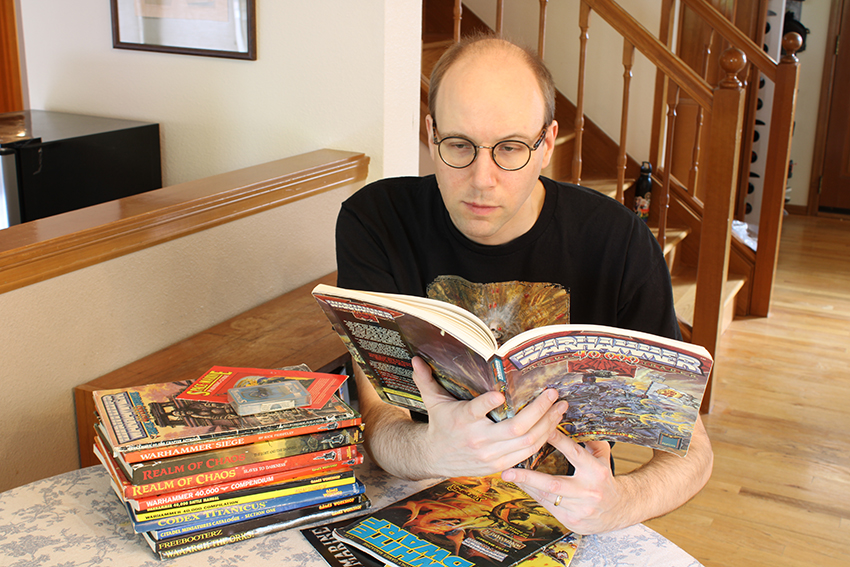
Of course, I reasoned, if Warhammer 40,000's creative direction had evolved as much as Magic's had in a similar timeframe, I might need to modernize my reference library. I hit some more books—books that had been published in this millennium.
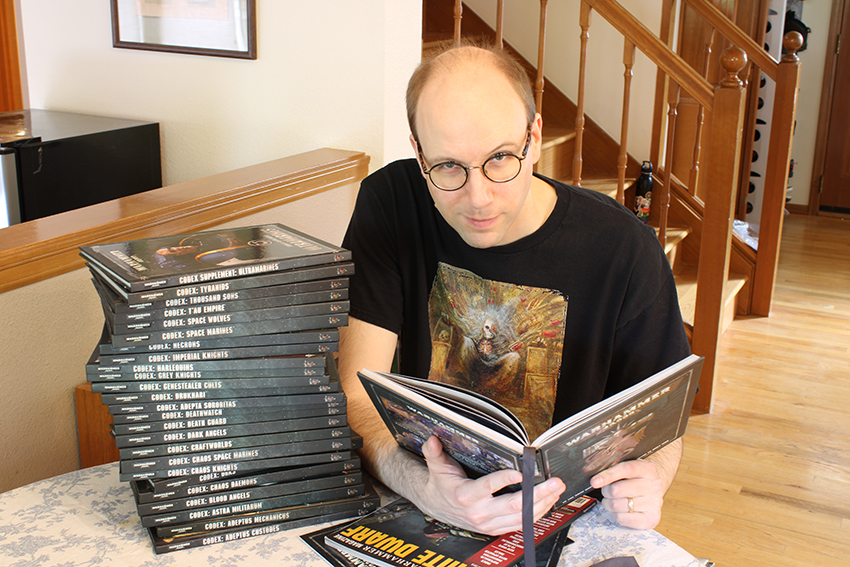
The Factions
When Mark Heggen, the product architect for Warhammer 40,000 Commander decks during the early stages of its design, asked me to design the product, he had three requests:
- Make four preconstructed Commander decks. These would be easy entry points for players new and familiar with Magic.
- Give the Necrons prominence in the product. They are a corps of fleshless mechanoids, opposed to all other races of the galaxy. Games Workshop is supporting them with an expanded miniatures range and many product features during the time that the Warhammer 40,000 Commander decks would be released.
- Each card in the product should have new art, themed to Warhammer 40,000.
Using Mark's initial requests as our starting point, the design team and I discussed what the decks should be about. We quickly hit on the idea that piloting each deck should feel like playing a miniatures game with an army themed to one of the factions. Your commander would be a leader bringing their forces into battle. Each creature card in the deck could represent a different unit type that's represented by a miniature in the Warhammer 40,000 army.
This last item seemed particularly promising. In many ways, the worldbuilding emphasis of Warhammer and of Magic are very similar. Both games need concepts for a variety of creatures in various sizes, some of which can fly, that look like they belong together in some way. The creatures need to be instantly distinguishable even though their representations are quite small.
As we discussed the decks' themes, somebody said, "One of the decks should be a Space Marine deck." Space Marines are easily the most popular faction in Warhammer 40,000. This gave me pause.
To a dedicated Warhammer 40,000 fan, the difference between a Tactical Marine, an Intercessor, a Grey Hunter, an Infiltrator, a Primaris Incursor, a Sternguard Veteran, and a Chaos Marine may be obvious. But to a Magic player with no previous experience with Warhammer 40,000, they might all look like the same thing: a heavily armored Space Marine holding a gun.
It's important that players can easily distinguish one card from another; there have been Magic sets where we inadvertently made cards that looked too similar to each other, which caused players to make errors in the heat of a game. I wanted to reduce this risk by including a diversity of character concepts in each deck, taking advantage of all the distinctive silhouettes that Games Workshop's miniature designers had created for Warhammer 40,000's factions. This may seem to be at odds with our goal to make playing the deck feel like playing the corresponding army. Let me explain.
Games Workshop publishes a series of rulebooks called Codices for Warhammer 40,000, each describing an army you can play in the game and detailing the rules for playing that army. In a Codex, each type of unit has an entry that describes its combat statistics, any special rules associated with it, and its faction keywords. Keywords in Warhammer 40,000 work differently from Magic. In Warhammer 40,000, a keyword is used similarly to how creature types are used in Magic; they don't have any rules meaning on their own, but rules may refer to them in some way.
For example, a Grey Hunter unit has three different faction keywords, each representing a more specific faction than the one before it: Imperium, representing the entire human empire with its capital at Terra; Adeptus Astartes, representing all of the Space Marines that are loyal to the Imperium; and Space Wolves, representing a specific Chapter (there are about a thousand) of Space Marines. All units in your army must share a faction keyword, but there are stronger synergy bonuses for more specific faction keywords, encouraging players to build tightly themed armies.
For Warhammer 40,000 Commander decks, however, we wanted to make sure that the cards were visually and conceptually distinct, and we also wanted to show off as much of the fantastic worldbuilding of Warhammer 40,000 in the limited number of cards that we could make. This meant that our decks should be themed to the largest, most diverse faction keywords.
For each of these top-level factions, we made our best guess as to the color identity that would best fit that faction, along with a central color that would dominate its strategy—a challenge Mark Rosewater covered already. We also noted how many Codices had been published for armies of that faction. Armies with a lot of Codices would have lots of concepts to choose from.
Aeldari: Five-Color
The Aeldari are an ancient race of humanoid aliens, resembling in some ways popular fantasy elves.
Codex count: 3
Central color: Blue. This race of agile psykers exemplifies blue's evasive qualities and mastery of mind magic.
Other colors: The Aeldari have such a dazzling variety of specialist troops, many of which feel very aligned with one of Magic's colors. Capturing them all adequately might require a five-color deck!
Chaos: Blue-Black-Red
Codex count: 5
Central color: Red. The very concept of chaos and emotion is squarely in red's domain. In addition, Khorne's berserk battle-fury and Slaanesh's hedonism fit well into red.
Other colors: Tzeentch's fateweaving ways felt very blue, while Nurgle's domain of pestilence and disease made sense in black.
The Imperium: White-Blue-Black
The Imperium is the primary human faction, but in the 41st millennium humanity has descended into a medieval dark age, hampered by ignorance, totalitarianism, and constant warfare.
Codex count: 11
Central color: White. The Imperium has one thing in seeming inexhaustible supply: people. Going wide with lots of tokens seemed like a strategy we could support.
Other colors: Blue and black. We wanted to make sure that the knowledge-hungry Adeptus Mechanicus were well represented. The fact that the people of the Imperium worship a corpse, have plastered skulls over every available surface, and that the greatest heroes of humanity are nicknamed "the Angels of Death" seemed to indicate that black should be the deck's third color.
Necrons: Blue-Black-White
The Necrons are an ancient race who transferred their consciousnesses into immortal robot bodies.
Codex count: 1
Central color: Black. Necrons are undead robots that reform their bodies and return to battle after they've been destroyed. Undeath is squarely in black's domain.
Other colors: Necrons, especially Crypteks, are technologically sophisticated, which implies blue should be one of their colors. They have a rigid hierarchy in their ancient society, which could indicate some white in their color identity.
Orks: Red-Green
Orks are violent, destructive aliens who like nothing more than loud noises and a good fight.
Codex count: 1
Central color: Red. Orks are enthusiastically destructive.
Other colors: Orks are essentially satisfied with their own natures and are happy to keep doing things as they have always done. These are green traits. Plus, they're literally green!
T'au Empire: Green-White-Blue
The T'au are a young race of aliens who rely on constantly improving technology along with a belief that individual differences should be subsumed in the interest of the Greater Good.
Codex count: 1
Central color: Blue or white. The T'au's vigorous rate of technological advancement is a blue element. However, the very concept of the philosophy of the Greater Good is clearly white. It was easy to imagine leaning into one color or the other, depending on other factors.
Other colors: We didn't want to leave the Kroot (the most important other species in the T'au Empire) out of the picture, and they, with their woodcraft and affinity for animals, felt very green.
Tyranids: Green-Blue-Red
These extragalactic aliens use bioengineered organisms in lieu of conventional technology and can evolve specialist creatures to meet any threat.
Codex count: 2
Central color: Green. The Tyranids have the biggest monsters in the game. They eschew traditional technology; all the weapons and spaceships are living organisms. They evolve rapidly in response to conditions on a planet.
Other colors: The Tyranids are all linked together with a psychic hive mind and are constantly improving, which indicates some blue in their color identity. Genestealer Cults (Tyranid-human hybrid creatures) foment revolution on planets of the Imperium, a red trait if ever there was one.
When selecting which factions to turn into decks, we established some criteria:
- Every color should be represented at least once among the decks.
- Factions which suggested mechanical themes that would be fun and easy to implement should be preferred over ones that didn't.
- Each deck should have a play style that was distinct from the other decks. This probably meant that each deck should have a different central color.
- Decks with a low codex count were risky. Would there be enough card concepts to fill an entire Commander deck?
- The Imperium was a shoe-in. This is the closest thing to an "audience point-of-view" faction that exists in the universe of Warhammer 40,000.
- The Necrons were a shoe-in. We wanted to support and be supported by broader Games Workshop products. If we were going to take a risk on a "one Codex army" the Necrons would be that army.
When it all shook out, these were the factions we chose:
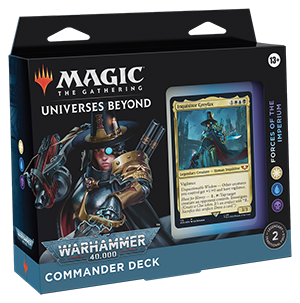
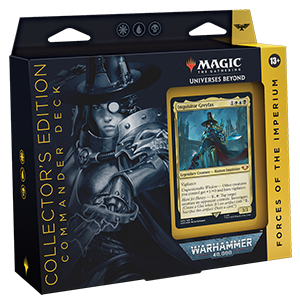
Imperium (white-blue-black): As the largest, most popular, and most identifiable faction, we had to use the Imperium. We could incorporate a variety of cards that built up big armies of soldiers and rewarded you for having a large army.
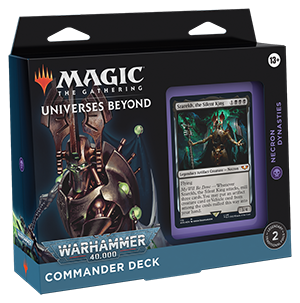
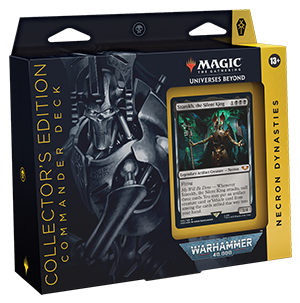
Necrons (mono-black): We didn't want to make two decks that were the same three colors, or even one that was a two-color subset of another's color identity, so we decided not to make the Necrons a multicolor deck. We thought that, with a strong artifact theme coupled with reanimator elements, there was a novel and compelling mono-black deck to be built. Plus, we liked the idea of putting a bunch of skull-shaped mana symbols all over the cards representing robotic skeletons.


Tyranids (green-blue-red): Ramping into huge creatures is classic Commander gameplay at its best. Despite a codex count of only two, the clear alignment between the Tyranids' creative identity and a proven play style made them a good choice.
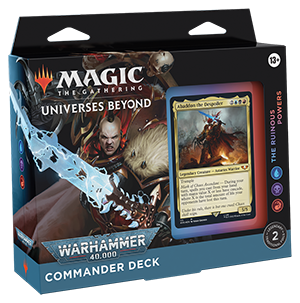
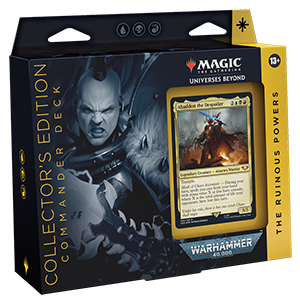
Chaos (blue-black-red): We'd made a deck with the theme of "chaos" before, in the Commander (2016 Edition) UBRG deck commanded by Yidris, Maelstrom Wielder, so I knew it was possible to implement a deck with chaotic, high-variance effects that would disrupt the rest of the table's plans. Plus, I just love the concept of the four Chaos Gods, the corruption of the Warp, and all the different daemons.
The Mechanics
Early in the design process, we explored a mechanic called "ballistic skill." In Warhammer 40,000, many units are equipped with firearms, and some of them specialize in shooting but aren't good at fighting hand to hand. Others take the opposite approach, needing to close with the enemy so they can get to grips with them with sword or claw. What if Magic's Warhammer 40,000 Commander deck cards had ballistic skill, power, and toughness?
We experimented with several implementations. The most promising worked as a sort of double strike variant, where a creature dealt combat damage equal to its ballistic skill during the first strike step of combat. Ultimately, the gameplay wasn't interesting enough.
As we designed cards and playtested the decks, we noticed that the gameplay was getting too complex. Every new card was a rare, and every card was doing something quite distinct. We used two means to reduce complexity. The first was to make "uncommon" cards that were simpler and less impactful than we would normally make rare cards. We assigned uncommon expansion symbols to these cards even though they appeared at the same frequency as the new rare and mythic rare cards in the same product. (This is different from how we have used the uncommon expansion symbol in previous Commander decks, where it also indicated new cards that appeared in more than one, but not all, of the decks in a set.)
The other means we used to reduce complexity was to design a mechanic for each deck, so there would be multiple cards in each deck that had mechanics in common with each other. This served to reduce cognitive load by allowing players to "chunk" the functionality of those cards together. Initially, each deck had a new mechanic, but as we continued to iterate on the mechanics, two of them drifted closer and closer to existing mechanics until we decided to simply use repeated mechanics for those decks.
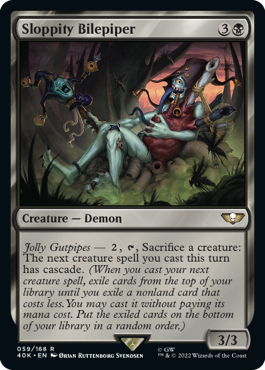
For the Chaos deck, we chose the cascade mechanic. This mechanic means, "When you cast this spell, exile cards from the top of your library until you exile a nonland card that costs less. You may cast it without paying its mana cost. Put the exiled cards on the bottom of your library in a random order."
It debuted in Alara Reborn, and the effect it has depends heavily on the mana value of the card it appears on. On a high mana value card, such as Enlisted Wurm, it is highly chaotic; you might cast a five-mana spell, or a one-mana spell, depending on which is closer to the top of your library. On a low mana value card, such as Shardless Agent, the cascade ability typically functions more like a tutor, searching your library for a card with mana value two or less and casting it for free. We used cascade pretty extensively in our previous chaos-themed Commander deck, Entropic Uprising from Commander (2016 Edition).
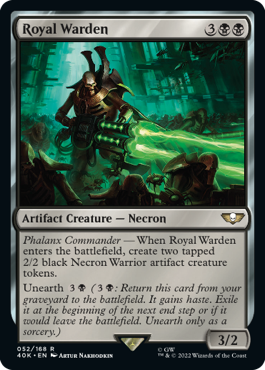
For the Necrons deck, we chose the unearth mechanic. This mechanic means, "[COST]: Return this card from your graveyard to the battlefield. It gains haste. Exile it at the beginning of the next end step or if it would leave the battlefield. Unearth only as a sorcery."
It first appeared in Shards of Alara. We wanted a mechanic that operated from the graveyard and allowed the Necrons to return to the battlefield after being destroyed. Unearth is a great mechanic, allowing you to temporarily recur a creature, but only once. It works well on cards that are both aggressively slanted, and value-generating cards that grind out advantage over time.
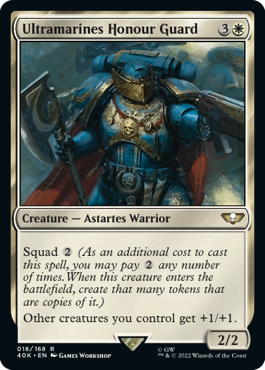
For the Imperium deck, we created the new squad mechanic. This keyword appears on creatures. When you cast the creature spell, you may pay the squad cost any number of times. When the creature enters the battlefield, you create a token that's a copy of it for each time the squad cost was paid.
Squad allows relatively simple creature designs to scale in power as the game progresses. It also represents the Imperium's numerical advantage over the other factions in Warhammer 40,000.
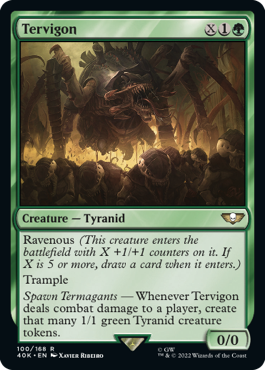
For the Tyranid deck, we created the ravenous mechanic. This keyword also appears on creatures. Ravenous means "This creature enters the battlefield with X +1/+1 counters on it. If X is 5 or greater, draw a card when it enters." We wanted Tyranids to scale with the length of the game as well, but for the Tyranid deck, bigger is better.
Throughout much of the design process, ravenous didn't have the card-draw rider; it was simply nicknamed "the Ivy Elemental mechanic." During playtesting, we found that players had more fun if they could cast more than one spell in a turn during the late game. We added a threshold to draw a card to incentivize players to sometimes cast two spells in a turn, rather than always maxing out their X values on a single spell.
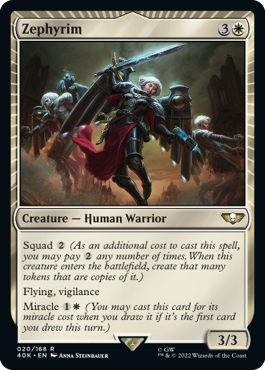
We also made some use of other keyword mechanics from Magic's past, if they felt thematically appropriate. We made some exciting new cards with the miracle mechanic from Avacyn Restored, for example! This mechanic felt like a slam dunk for the Adepta Sororitas, the warriors of the Imperium's Church.
The Creature Types
There were two goals that were in conflict when it came to the creature types on Warhammer 40,000 Magic cards:
- Express Warhammer 40,000's unique worldbuilding though the medium of Magic cards.
- Integrate the new cards into Magic's deck-building and gameplay ecosystem, making them desirable for Magic players to collect.
Magic's approach to such things has clear precedents. Its Multiverse contains many planes, some of which, for thematic reasons, want to deviate from the norm in how they name things, including species. For example, a fish-person could be called a merfolk on Dominaria and have a fish's tail, while a fish-person on Theros might be called a triton and have a fin on their head, and a fish-person on Shadowmoor might be called a selkie and have seal features. All three of these creatures have the creature type Merfolk.
Players can use any of these cards in their Merfolk deck, and Master of the Pearl Trident will make them all more powerful. The Worldbuilding team gets to express the themes of the individual planes via card names, while the unifying creature type enables cards from different sets to work together in the same deck.
All of this means that we typically only add to the finite but large list of creature types when we have a good reason that outweighs the costs. Whatever solution we deployed for the Warhammer 40,000 Commander decks should make sense for our players and be sustainable for future Universes Beyond releases.
Some thoughts on individual creature types:
- Baseline Human = Human. This seems straightforward at first, until you realize that in the 41st millennium there are several common human subspecies ("abhuman" in Warhammer 40,000), as well as people who have been modified after their birth to the point where they are no longer considered human.
- Ogryn = Ogre. The analogue between Warhammer 40,000's abhuman strain and the fantasy creature is clear.
- Ratling = Halfling. The analogue between Warhammer 40,000's abhuman strain and the fantasy creature is clear.
- Kin = Dwarf. The analogue between Warhammer 40,000's abhuman strain and the fantasy creature is clear.
- Beastmen = Mutant. There isn't a clear analogue for the goat-headed beastmen in Magic, but they are often described as "mutants."
- Navigator = Mutant. There is no analogue to navigators in Magic either. However, they are frequently described as mutants, so the Mutant creature type seems appropriate.
- Space Marine = Astartes. While Space Marines are born human, there are frequent comments in the background material that they are no longer human; they are both more (in martial prowess) and less (in connection to society) than human. The fact that they have two hearts, acid saliva, and can steal peoples' memories by eating their brains, among other abilities, supports this idea.
- Adeptus Custodes = Custodes. As Astartes are to humans, so are Custodes to Astartes. The exact capabilities of Custodes aren't spelled out in detail, but I thought that Custodes also needed their own creature type.
- Primarch = Primarch. We had originally considered the Primarch Roboute Guilliman to command the Imperium-themed deck. Though Guilliman doesn't appear here, we still had two daemon Primarchs, Mortarion and Magnus. If we made another Warhammer 40,000 release in the future, we would want to make a Guilliman card, so we wanted his creature type to be ready for him. It's best to prepare for success.
- Tyranid = Tyranid. We could call them "Creature — Beast," our catch-all creature type for hybrid animals, but the word beast is most strongly associated with Orks in Warhammer 40,000. I disliked making a new catch-all creature type, such as "Alien" or similar, because it defines the creatures with it in relation to humanity, rather than on their own terms.
- Necron = Necron. The Necrons clearly embody an undead archetype and physically resemble skeletons. In Magic thinking, the appearance of a thing is often more important than the origin of that thing. For those reasons, we considered the Skeleton creature type for Necrons. However, some of the Necrons deviate far from a skeletal form, incorporating hover jets or other purely mechanical-looking parts. In the end, it made sense they got their own creature type, just like the Tyranids.
- Daemon = Demon. This is straightforward. The daemons of Warhammer 40,000 are simply a variant spelling of the word demon.
- Ork = Orc. This is straightforward. The Orks of Warhammer 40,000 are simply a variant spelling of the word orc.
- Gretchin = Goblin. Gretchin are clearly Goblin analogues.
- Aeldari = Elf. Aeldari are clearly Elf analogues.
- T'au = T'au. The closest analogue to T'au in Magic are Vedalken, but Vedalken are unique to Magic's worldbuilding: they are not an archetypal fantasy race. That is an important distinction to make.
Many creature cards have both a "species" creature type and a "class" creature type. A couple of class-related things that have come up in our design work:
- Inquisitor = Human Inquisitor. Normally we give inquisitors in Magic the creature type Cleric because they are an analogue to real-world historical religious inquisitors. In the Warhammer 40,000 universe, however, the Inquisition is a separate organization from the Church, and Inquisitors are more like high-level detectives or superspies. We decided that Inquisitors were too important a part of Warhammer 40,000's worldbuilding to compromise on their creature type, so we made a new Inquisitor creature type for them.
- Rogue Trader = Human Rogue. The Imperium has a hereditary class of spaceship captains who are authorized to conduct trade, exploration, and war outside of the bounds of the Imperium. We considered several different creature types for our Rogue Trader: Rogue, Noble, and even Pirate. In the end, we decided that the Rogue creature type would have the most mechanical synergy with existing Magic cards, and the fact that the word "rogue" itself was in the name "Rogue Trader" was a decisive factor.
Universes Beyond
The promise of Universes Beyond is the opportunity to see different intellectual properties expressed in the medium of Magic cards. We leaned into that promise by offering more creatively cohesive Commander decks than we normally create. A typical Commander deck released in conjunction with one of our Standard-legal sets has ten new cards, which are all creatively linked to the setting of the main booster set, and 90 reprinted cards, which are chosen for their mechanical function from any of Magic's settings. For the Warhammer 40,000 Commander decks, we themed every single card to Warhammer 40,000's worldbuilding.
We knew that all four of the decks should be heavily creature based, since armies of creatures and units represent the heart of Warhammer 40,000's fantastic gameplay. With hardly any suitable creature reprints to choose from, we knew that we would need to create a lot of new cards to represent the various creatures. We decided that 42 new cards per deck would give us enough flexibility to create whatever cards we needed to, and we could fill out the remainder of each deck with reprints.
When choosing reprints, we considered whether the name of the card made sense in the context of Warhammer 40,000. A card like Simic Growth Chamber is a strong, appealing land card, but there's no such thing as the "Simic" in Warhammer 40,000's setting. Likewise, we had to carefully consider creature types. In the end, we only found a small handful of creatures that felt plausible to reprint in the product, and only actually reprinted a single creature card (plus a few token-making cards). Most of the reprinted cards are lands, artifacts, and noncreature spells.
Because of how heavily factionalized Warhammer 40,000's setting is, we decided that, for reprinted artifact cards that appeared in more than one deck, we would create bespoke art that was themed to the deck's faction.

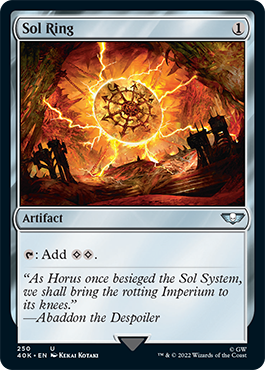
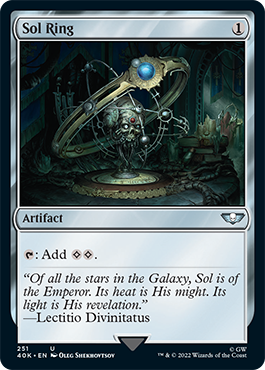
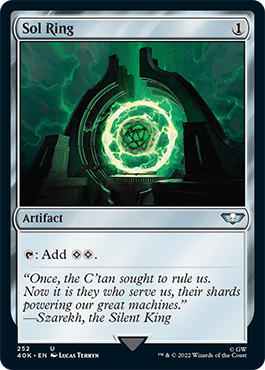
We had a lot of fun figuring out what a Sol Ring would be to each of the four factions, for example. We also made bespoke basic land art for each of the factions. Our art pipeline was strained to the breaking point by then; we decided that nonbasic land art could be shared between decks, as these lands represented the battlefields that were being fought over, which could come under anyone's control over the course of a long campaign.
Art and Creative Text
Normally my work is focused on creating the unique gameplay of Magic sets. However, I've dipped my toe into worldbuilding a few times; I sometimes assist in toplining the art concepts for cards, I helped write the world guides for Dominaria and Kaldheim, and I contributed to creative text writing for Modern Horizons. As one of Studio X's Warhammer subject-matter experts (SMEs), I became involved in tasks that are well outside of my usual lane.
The toplining team had its hands full coming up with new and distinctive concepts for the many lands and mana-producing artifacts that would need new art. The toplines for creature cards were straightforward, as we could send reference photos from Games Workshop's online catalogue to the artists as reference.
For a lot of other cards, we had to take Warhammer 40,000's existing worldbuilding and extrapolate upon it. What would an Imperial temple that's been desecrated by genestealer cultists look like? What's a good visual pun involving a C'tan Star God? How would invasive Tyranid sessile organisms change a landscape?
I was also involved in reviewing sketches as they came in from the artists. This mostly involved making sure that the character designs and other details were on model. Of course, the licensing team at Games Workshop also reviewed everything, but I helped to ensure that at least some of the errors would be corrected before they even saw them.
Making card names was easy. The creature cards were, by and large, simply named the same thing as their miniature counterparts, and most of the new spell cards were named after famous phrases from Warhammer 40,000's rich history.
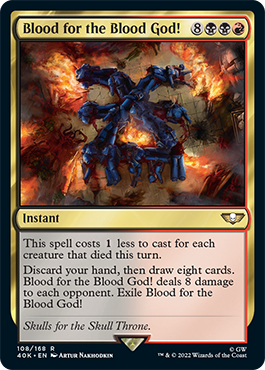
Flavor text was more of a challenge. The creative text team combed through dozens of Warhammer 40,000 books to find the choicest quotes. Where nothing suitable was found, we wrote new ones! With so many of us fans ourselves, we worked so it all feels part of the same tapestry in the final product.
One exciting opportunity that was particular to working on a Warhammer 40,000 product was Games Workshop's massive catalogue of illustrations. These ranged from book covers and box covers to interior illustrations from books. The standard of quality on these paintings are extremely high, and many of them were composed in such a way that they could be repurposed as Magic card illustrations—so some were. In some cases, we simply found an illustration that matched a card we'd already designed. In others, we took an illustration and designed a card to fit the art.
Once we had decided to use this pickup art on Magic cards, I made it my mission to get a piece by John Blanche, my favorite fantasy artist, onto a Magic card. I have a couple of Blanche prints hanging in my hallway. For a long time, it looked like it wasn't going to work out, but late in the process, the stars aligned, and we had the perfect spot for a Blanche painting. And it was even one of the pieces hanging on my wall!
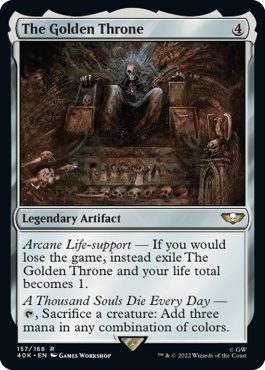
I could keep talking about the specific design decisions we made for this product for ages, but I think I've covered the unique challenges and opportunities presented by a Warhammer 40,000 Magic product already. I believe that the decks present some of the most fun "biodome play" (using preconstructed decks to battle against each other) that we've ever created.
Give them a try! I think you'll enjoy Magic's trip into the grimdark millennium of the 41st century with Warhammer 40,000 Commander decks.

